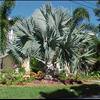This plant may be available to buy
Click the banana to see

|
In general, palms are very easy to grow and there is little significant variation in culture from palm to palm. Properly fed, most palms are carefree For outdoor palms planted in the soil, your primary consideration is location - the conditions you provide. You must match conditions in the spot you have selected to a palm variety which will want to live in that environment - most are full sun trees For houseplant palms, please go here Some palms can take a wet spot - enjoying more moisture than other varieties. For example, the Royal Palm and the Paurotis Palm both handle wet pretty well Most other palms and cycads like the sago like a dryer outdoor condition. Almost no palm handles salt spray or the big winds off the beach, but the Coconut is one exception Tip Starting with a new palm in a pot, one of our big secrets is planting with manure Get a 40 lb. bag of top quality (most expensive) composted cow manure and thoroughly incorporate the manure with the soil in the planting hole. This also means digging a larger hole than you might expect, but it's well worth the added effort for the health of your palm The next consideration is to plant the palm at exactly the same level in the outdoor soil as it was in the pot. If you make a mistake, a tiny bit higher out of the ground is OK, but NEVER lower Planting too low won't kill your palm immediately, but can be fatal over time and cause ongoing illness until death occurs Water in your palm as we explain here Thereafter, wait a few weeks before adding fertilizer. Then fertilize 6X a year NOTE We get a lot of email asking "my palm is getting yellow leaves so what should I do?" Be aware that the natural course of leaves on plants, including palms and cycads, is first green, then turning yellow, and finally brown and dry The yellow stage is where the frond is losing its chlorophyll as it is being re-absorbed into the plant. The final brown stage is the completion of the nutrients re-absorption process So... if you cut off fronds too soon, you are actually depriving the plant of its natural technique to conserve nutrients. Best is to wait until a frond is totally brown and shriveled up small The exception is be worried about yellow or brown fronds is if they are occurring in the center "new growth" area If new fronds soon turn yellow and head for brown, you have a serious nutrition problem. You are not feeding properly. Bugs may also be the problem, but not nearly as likely as improper feeding Health Care Folks don't realize there is very little useful technology if a plant gets sick There are very few cures With some insect problems, chemicals can help - sometimes. With fungus - some chemicals can help. With viruses and bacterial infections, there is virtually no way to help your palm Your best strategy by far is to plant your palm correctly in a well suited location then feed properly. By insuring you have provided the best conditions and good food on a very regular basis, you will have done the best you can Problems / Solutions Overview Palm aphid - Insecticidal soap or Cygon or Orthene Scales - Supracide or Cygon Spider Mites - Most miticides are OK, but washing off the mites with water will work as well Banana moth - Sevin or Lindane Palm Leaf Skeletonizer and other caterpillars - Dipel (bacillus thuringensis) Palmetto weevil - Not much works but you could try Dursban or Lindane Leaf Spot (fungus) - Copper based fungicide or maneb fungicide or mancozeb fungicide Sooty Mold - Usually do nothing or wash it off. Go after the ants that may be "farming" the aphids which have led to the sooty mold Bud Rot, Root Rot, Trunk Rot and Wilting - Call in a professional arborist Lethal Yellowing - No help, no cure |
